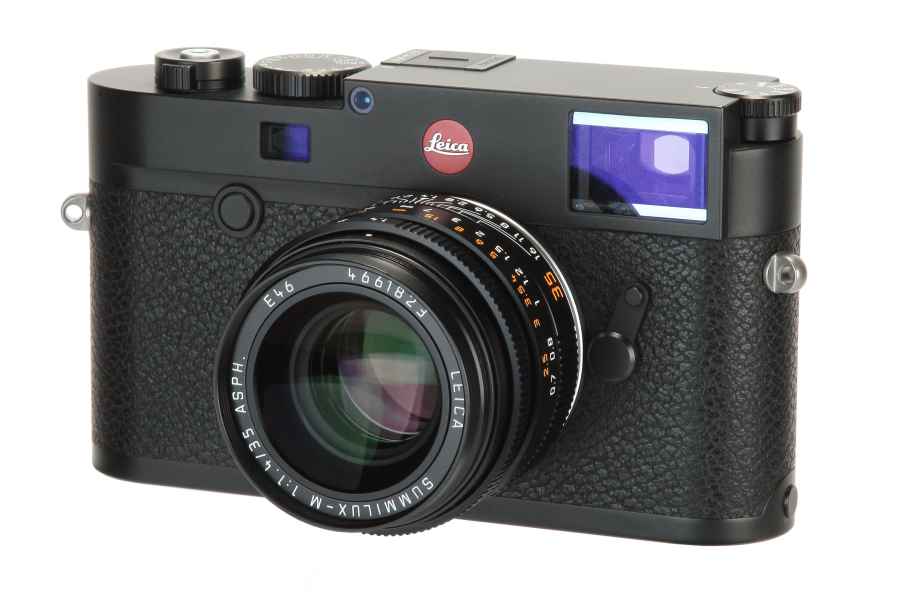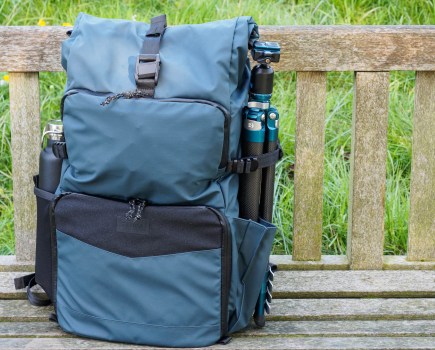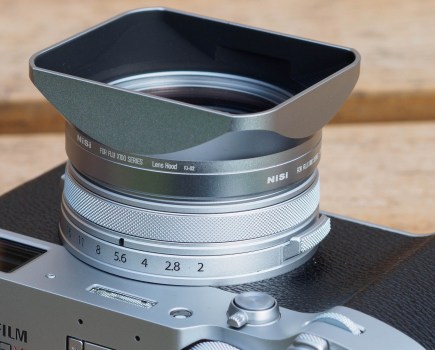Read our full in-depth review of the Leica M10
Leica M10: At a glance
- £5,600 body only
- 24-million-pixel CMOS full-frame sensor
- ISO 100-50,000
- Leica Maestro-II processor
- 5fps continuous shooting for up to 30 frames (DNG) and 100 frames (JPEG)
- +3/-3EV exposure compensation control
- Compatible with Leica Visoflex (Typ 020) electronic viewfinder

The Leica M10 no longer features the M branding alongside the famous red dot
In the last couple of years we’ve seen Leica announce some sublime cameras, the Leica Q being just one example of a model that many photographers aspire to own. We’ve now been given reason to get excited again with the release of Leica’s latest creation – the Leica M10. This latest M series rangefinder follows on from the iconic Leica M9 and sets about being slightly different to the Leica M Typ 240 with a multitude of refinements and improvements that are aimed at purists who’s sole interest lies in stills photography.

A view of the top plate showing its simple arrangement of dials and on/off switch
Stripped of movie recording and the Typ model identity that’s been associated with many Leica models in the past, the Leica M10 has been designed as close as possible to the manufacturers analog M system cameras and becomes the slimmest digital M series of all time – so slim in fact that the dimensions of the Leica M10 are now identical to those of analog M-cameras. With more than 60 years of rangefinder expertise and over 11-years of digital M camera development under their belt, we like to think Leica have once again created something truly special with the Leica M10, but have they been successful in doing so?
Features
Behind the Leica M10’s M lens mount lies a new full-frame CMOS sensor that features a 24-million-dot pixel resolution and omits a low-pass filter to guarantee maximum sharpness. Specially adapted for Leica M-lenses, including those that date back to the 1950’s, we’re told it’s a different sensor to those we’ve seen fitted within the Leica Q and Leica SL. The partnership of a newly developed Leica Maestro-II processor alongside this new chip delivers what Leica claims is a two stop improvement on what we’ve seen before.

The Leica M10 updates Leica’s traditional and much-loved recipe with a new 24MP sensor
The ISO range spans from 100-50,000, with the option to shoot continuously at up to 5fps for up to 30 shots when shooting in the Raw (DNG) format, or 100 frames set to JPEG. These shooting speeds are also made possible thanks to the camera’s 2GB buffer memory, making it the fastest M series camera ever made. The shutter speed range runs from 8secs-1/4000sec, and although you might be looking at it thinking there’s no exposure compensation dial to be found on the body, there’s the option to assign the rear thumb dial to this task where you can control it by up to +3/-3EV.

A view of the rear of the Leica M10 showing the extent of the exposure compensation range
The news regarding the viewfinder is that it has been extensively reworked, making it the best of any we’ve seen on a digital Leica M. The widest focal length it covers is 28mm and to improve the view of subjects captured within the frame, the field of view sees a 30% enlargement, with the magnification increasing from 0.68x to 0.73x. A 50% increase of the eye-relief is also designed to make the rangefinder more convenient to use for photographers who wear glasses.

The Leica M10’s viewfinder features LED illuminated framelines
Purists are more likely to use the optical viewfinder more than live view, but the M10’s 3in, 1.04 million pixel screen gets round the problem of parallax errors (where the view offered by the optical viewfinder is not the same as that captured through the camera’s lens). The screen also offers a preview of depth of field and a detailed magnified view to check focus right across the entire frame, which you couldn’t do before. As well as this you’re given a preview of white balance and exposure via a histogram. The same view as the screen can be seen by slotting the Leica Visoflex (typ 020) electronic viewfinder (£360) into the M10’s hotshoe. This is the same EVF that’s used for Leica’s T-system. It hinges up through 90 degrees, features a sensor that detects when the user’s eye is raised to it and adds an integrated GPS module for geotagging. It’s just one of a multitude of accessories that’ll be made available for Leica M10 users.

The Leica Visoflex (typ 020) electronic viewfinder can be slotted onto the M10’s hotshoe. Note how it partially obscures the view of the shutter speed dial
Elsewhere, the Leica M10 continues to feature a single SD card slot that’s accessed via a removable metal battery plate. With a body depth of just 33.75mm (equivalent to four millimetres less than its closest relative, the Leica M Typ 240), a new battery has had to be used. It doesn’t offer the same stamina as the older, larger battery, but is claimed to last for approximately 600 shots before it needs to be recharged.

The Leica M10’s battery has had to be made smaller than that used in the Leica M Type 240
With video being left out in an effort to make the Leica M10 as pure and simplified as a rangefinder camera gets, you might assume WLAN connectivity has also been left out, but you’d be wrong. The M10 is the first M-Camera with integrated WLAN connectivity, which allows users to transfer pictures wirelessly to iOS mobile devices, as well as remotely control the camera using a dedicated Leica M app.
Build & Handling
The Leica M10 shares the same clean, minamilist styling that we’ve long associated with the Leica M system. Taking a closer inspection at the body identifies some design changes, most of which are found on the top plate and at the rear. The introduction of a new ISO dial is located in the same position you’d find the rewind lever on analog models like Leica M7. It means for the first time on a digital Leica M, all the essential shooting parameters such as focusing, aperture, shutter speed and ISO value can be selected manually without having to dive in and access the menu.

To adjust the ISO you’re required to raise the ISO dial. The red ring beneath gives you a visual clue that it is unlocked. The dial pushes down and locks with a reassuring click
The small size of the ISO dial means it only allows users to take control of the sensitivity between ISO 100-6400, however by lifting the dial and rotating it to its M setting, you’re given control across the full ISO range from the main menu. This can also be added to My Favourites – a freely configuable area of the menu where it’s possible to list your most-used functions for quick and easy access. Users who’d prefer to use Auto ISO can set the ISO dial to ‘A’ and cap the highest setting from the same ISO setup menu heading.

Setting the ISO dial to its ‘M’ setting allows you to control the sensitivity straight from the main menu. The ISO setup menu is also where you limit the Maximum Auto ISO value
At the rear of the camera you’re presented with three large buttons that align directly below the viewfinder to activate live view, playback and the menu. This simplified arrangement helps to give it an uncluttered feel in the hand. With no touch panel display, the four-way controller is used to navigate the menu. On the subject of the menu, this has also been made clearer and is now much like the main menu on the Leica Q.
At the front of the Leica M10 you get the usual frame-line selection lever (a mechanism that allows photographers to assess the field of view of lenses with different focal lengths without having to mount them), a silver lens release button, as well as a button located just beneath the focus window that can be used to pull up a magnified view on the screen or EVF to aid with precise focusing adjustment.

The lens release and focus magnification buttons on show at the front of the body
In typical Leica fashion, the build quality and finish of the M10 shouts first-class German engineering. With a chassis made of magnesium and top and bottom plates that are milled from solid brass blocks, you know it’s built to last. It features water and dust-resistant weatherproof seals to keep you shooting when you’re subjected to working in inclement weather and the black paint finish has changed ever so slightly to what Leica now calls a black chrome finish that offers a more even, gun-like appearance. It’s not exactly light on the scales at 660g (body only), but it is 20g lighter than the Leica M Typ 240.

Leica has engraved the model number down the side of the Leica M10’s hotshoe
As to be expected from a Leica M, the M10 is extremely robust. From the moment you pick it up you know you’re holding onto something that could quite easily survive a war zone. The camera’s dials rotate with great precision and offer excellent feedback, while the three buttons at the rear are positive to use. The only thing to point out here is that they’re not illuminated, but neither is the four-way controller, the shutter speed dial, or ISO dial on the top plate.
First Impressions
You certainly get the impression that Leica has worked hard to reach their goal of embodying the true essence of photography with the M10. By leaving out what’s not seen as being absolutely essential by contemporary photographers, Leica has developed a camera that goes back to its roots and focuses on the special bond that should be created between a stills photographer and their camera.
It’s a camera that feels exquisite in the hand and after using the Leica M10 for a couple of days, I must say that it seems to strike the perfect blend between what’s quintessentially Leica and what also feels like a practical camera to use in the real world. Just like a Leica M camera ought do, it makes you feel like you are creating a picture and observing the world in much closer detail.

AP’s Michael Topham tries out the Leica M10’s viewfinder prior to the camera’s official release
One of the biggest achievements has been shrinking the electronics into a more confined space, which should ultimately make it appeal to analogue Leica M camera users who’ve been patiently waiting for a digital M with the same dimensions and ergonomic features. From a quick inspection of our images taken on a working production sample, the sensor seems to produce the goods, delivering usable results at up to ISO 6400 and beyond. We’ll have to wait until we run it through the lab before we bring you our full verdict on its image quality performance.
Another new feature that I found particularly useful is the option to shift the focus magnification right to the edge of the frame. This makes manual focusing away from the centre of the frame much easier when an image is being composed via the screen or the EVF. Shifting the magnification around the frame isn’t particularly fast, but for times when you’re subject is positioned off-centre it’s useful.

There’s a certain knack to raising and unlocking the the Leica M10’s ISO dial
Having the option to now adjust ISO sensitivity from the corner of the body is a real boon. The ISO dial itself is small, but by having the option to set it to its ‘M’ setting it means you can also control it the same way as you did before via the main menu. The first time you get hands on the camera it’s not immediately obvious how to raise the dial to unlock it, but I quickly found pinching the dial with your thumb and index finger before pulling it up is easiest. In its down locked position there’s no chance of the dial being knocked or adjusted accidentally. Whilst out shooting with the camera, I found myself leaving the dial in its raised position to make it slightly faster to adjust ISO on the fly. It was pushed when I knew I’d be working with the same sensitivity over prolonged spells. The red ring around the base of the ISO dial is a nice touch and is a useful visual reference to remind you it’s not locked. If you try to lock the ISO dial between ISO settings it refuses to do so and the dial stands proud of the top plate.

The Leica M10 isn’t light, but it feels well balanced and can be used single handedly
It goes without saying we’re all very excited by the recent launch of the Leica M10 here at AP and we’re hopeful that we’ll be able to bring you our full review of the camera in the next few weeks.
Price & Availability
The Leica M10 is scheduled to be available from 19 January 2017, at a suggested retail price of £5,600 including VAT. As well as an all-black version of the camera, Leica will also produce the M10 in a black and silver finish.

A press image of a black and silver Leica M10
Accessories
As previously mentioned, the Leica M10 will be supported by a wide range of accessories for those who wish to personalise their camera and make it just that little more special. As well as the Visoflex (typ 020) electronic viewfinder (£360), Leica will produce their own thumb rest for the M10 that’s finished to the same standard as the body and is secured by push-fit into the camera’s hotshoe. In addition, Leica will produce a screen protector, leather holster, a finger grip, as well as a selection of leather straps and cases.

Leica will produce a thumbrest for the Leica M10 users, which attaches via the hotshoe
Sample Image Gallery
After our Leica M10 press briefing, we were handed a working production sample of the camera to try out for a couple of days prior to its official release. The camera was supplied with the Leica 35mm f/1.4 SUMMILUX-M ASPH lens and the Leica Visoflex (typ 020) electronic viewfinder. We’ve uploaded a selection of images taken with the Leica M10 for you to view over at our Leica M10 Sample Image Gallery.
Leica M10 review
Two weeks after getting our hands on an early sample of the camera, Leica sent us a production sample of the M10 to review. Head over to our Leica M10 review where you’ll be able to read more about the camera’s handling, build quality, performance and image quality.








